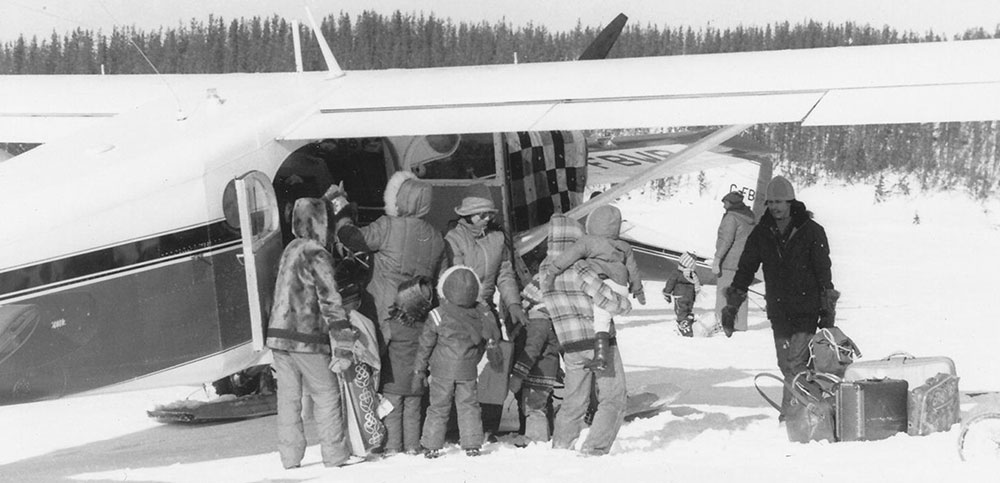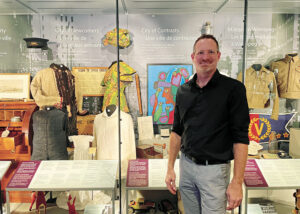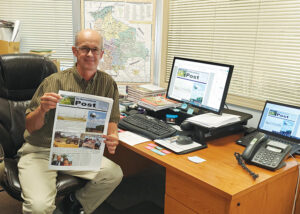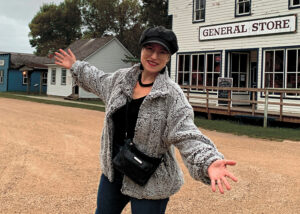“History,” wrote American poet Maya Angelou more than 20 years ago, “despite its wrenching pain, cannot be unlived, but if faced with courage, need not be lived again.”
Canada’s Truth and Reconciliation Commission (TRC) has completed four years of hearings and investigations, witnessing testimonies from some 7,000 survivors of Indian Residential Schools and their legacy. As TRC chair Murray Sinclair repeatedly reminds us, “This legacy is not an Indian problem; it is a Canadian problem.”
And it is a church problem as well. Even we settler Mennonites are implicated in this tragic colonial history, but I am passionate about exploring how to build better capacity within our Mennonite community for deeper solidarity with our indigenous neighbours.
Solidarity most often arises from genuine empathy. Empathy, according to Webster, is the ability to imagine oneself in another’s place and understand his/her feelings, desires, ideas and actions. It’s not sympathy—feeling sorry for—which usually leads to paternalism. To come alongside others in their pain requires us to do our own work: To discover how our story is connected to theirs, such that our mutual healing and wholeness is, in fact, intertwined.
What follows are three prospects and three problems that we Mennonites bring to the task of building this kind of empathy with our indigenous neighbours, in order to embrace what I call a “restorative solidarity” that recognizes past and continuing injustices, and seeks to make things right.
Prospects
1. Mennonites have historically endured experiences of violence and displacement, which could potentially help us empathize with the suffering of indigenous people.
During the Reformation, Mennonites were heavily persecuted by both Protestants and Catholics, and for much of the 16th and 17th centuries in Europe were essentially undocumented people, who often could not legally own property or were denied citizenship.
Violence has also afflicted Mennonites more recently, including during and after the Russian Civil War and through the Second World War. Even here in North America, our distinctive ways were often held under suspicion by the dominant culture, and our religious practices and language sometimes suppressed. From 1918-25, Old Colony Mennonites in Manitoba and Saskatchewan who refused to send their children to public schools were fined, and had their livestock seized and sold to pay the fines. Some were jailed, and other families were reduced to destitution. During both World Wars, German-speaking people in Canada were often vilified and discriminated against.
To what extent has this history of marginalization taught us empathy with the wholesale suppression of indigenous languages and cultures through residential schools over the course of a century-and-a-half? Should not the suffering of our ancestors open our hearts to the far-more systematic and continuing legacy of oppression afflicting indigenous people and communities?
2. The ways in which our Anabaptist tradition leans toward justice and the right sharing of resources is another asset.
Do Canadian settler Mennonites today, however, suffer from hypermetropia, the ability to see things more clearly at a great distance? Is it sometimes easier for us to recognize human rights violations or social disparities in distant countries than to see them in our own urban neighbourhood or on the reserve next to our farm?
To take a personal example, my parents were deeply and sincerely involved with Mennonite Central Committee (MCC) refugee resettlement, and I am profoundly grateful to have grown up with people at our dinner table from many parts of Africa and the Balkans. Yet the only indigenous people we ever hosted for a meal were my two adopted Cree cousins. Why was the distance between our home and the indigenous neighbourhoods of Saskatoon greater than between us and Congo, Malaysia or Bosnia?
It may be that the standard of our settler Mennonite tradition of justice and peacemaking will be measured by our relationship—or lack thereof—with “the inconvenient Indian,” to quote Thomas King.
3. A third prospect is that most Mennonites coming to Canada were rural people, which meant they tended to settle in close proximity to indigenous communities, opening opportunities to build neighbourly relations.
But have we taken full advantage of this? Indeed, early Mennonite settlements were extremely insular, and rarely related even to other German-speaking immigrants! And more recently, as suburbanizing Mennonites have become increasingly indistinguishable from other middle-class Canadians, we, too, tend to remain aloof from first nation communities. How many of us have inherited a family farm located next to a reserve, but not inherited a tradition of relationship? There are exceptions, of course, but a significant gulf between settler Mennonite and indigenous communities persists.
Mennonites have, then, generally been well-positioned to develop genuine friendships and empathic collaborations with indigenous people. Insofar as these prospects have not led us into “restorative solidarity,” however, we must ask why.
This brings us to three equally distinctive challenges facing our community in its relationship with our indigenous neighbours.
Problems
1. There have been consequential silences regarding indigenous people in settler Mennonite versions of our history.
Like many settler Mennonites, my extended clan has produced multiple family history books. These books highlight how Catherine the Great invited Mennonites to settle the steppes of Russia/Ukraine in the late 1700s, from whence all four of my grandparents came in the 1920s. Yet no mention is made of the Nogai and Cossack peoples, traditional inhabitants of the Ukrainian steppes, being forcibly removed by the Tsarina just prior to my ancestors arriving (as noted by James Urry’s 1989 book, None but the Saints: The Transformation of Mennonite Life in Russia, 1789-1889).
Similarly, a century later and half a world away, Mennonite settlers from Manitoba and the U.S. procured land in Saskatchewan that had just been taken from Cree tribes by the Canadian government—but not a whisper of the latter is in our family books. In most cases, indigenous inhabitants are simply not a part of our settler Mennonite narrative.
This silence functions to perpetuate the dangerous fantasy that the land upon which we settled was uninhabited—a destructive myth that dates back to the medieval Doctrine of Discovery, which still undergirds rationalizations of the European conquest and colonization of the Americas. Or perhaps we think that it just doesn’t matter who preceded us in this place. But, as a Canadian TRC slogan puts it, it should “matter to me.”
Another common, and equally problematic, myth among many Mennonites is that we came to this land and made it better and more productive, insinuating that before Europeans arrived, the Prairies were neither tended nor cared for properly. Should we not rather appreciate and learn from traditional indigenous life ways, which, given the interlocking ecological crises brought on in part by extractive industries and agribusiness, may well prove to have been more sustainable than those we westerners have imported here?
Similarly inconvenient to our heroic pioneer narratives are those instances in which Mennonite settlers, like so many other European newcomers, survived initially only because of the aid, compassion and knowledge of their indigenous neighbours.
An example is the story of Emilia Wieler, told by her granddaughter in 1980 at the 70th anniversary of Tiefengrund Mennonite Church, Sask. Emilia and her husband Isbrand had come from Prussia and the U.S. to Rosthern, Sask., in 1894. But Isbrand died shortly after their arrival, leaving Emilia in a new country to raise a family of nine children. Soon there was nothing to eat, and in desperation Emilia sent two of her sons to a nearby Cree chief for help. The ice across the South Saskatchewan River was already breaking up, and it would soon be impossible to cross to the store in Duck Lake. Hearing of their desperate plight, the chief risked his life by jumping across the perilous river on the ice-floes to get to the store, then re-crossing it with much-needed supplies for the widow and her children.
Marlene Epp, in her 2008 book, Mennonite Women in Canada, offers numerous accounts of Mennonite pioneer women engaging with indigenous communities, whom they experienced as more helpful than “dangerous.” Katherina Hiebert, an émigré from Russia in 1875, was one of the first midwives to serve French, English, Metis and Mennonite communities in southern Manitoba; a well-known herbalist and healer, she received both advice and traditional treatments from local indigenous women. Yet such stories about Mennonite settlers who built robust relationships with indigenous people tend to be the exception, rather than the rule, of our historical narrative.
In sum, the perceptual problems nurtured by historical silences and Eurocentric myths can only be undone by seeking out the whole story—and an empathetic approach that seeks to listen to voices long suppressed or undervalued.
2. A second challenge in our commu-nity is recognizing, and coming to terms with, the way in which our suffering as a community may have actually distorted our perspective.
Martyrs Mirror, for example, chronicles our people’s persecution in order to confirm our tradition’s commitment to discipleship, shape our Anabaptist identity and make sense of our losses. On the other hand, martyrologies may contribute to a phenomena that social psychologist John Mack calls “egoism of victimization,” in which communities that have survived significant violence are only able to see their pain, but not that of others.
Larry Miller, previous general secretary of Mennonite World Conference, acknowledged at the Lutheran World Conference in 2010 that, “at times, we have claimed the martyr tradition as a badge of Christian superiority. We have sometimes nurtured an identity rooted in victimization that could foster a sense of self-righteousness and arrogance, blinding us to the frailties and failures that are also deeply woven into our tradition.”
Has a subconscious preoccupation with our own history of pain impeded our ability to relate to others who experience marginalization today?
Moreover, recent research—including with survivors of the Holocaust, Indian Residential Schools and the World Trade Center attacks—suggests that trauma resulting from experiences of violence can be passed down intergenerationally. To what extent might unresolved trauma be impacting our settler Mennonite capacity to feel empathy with other traumatized groups? If we, as a community, can recognize this impact and guard against the egoism of victimization, wouldn’t it stand to reason that our hearts would be more open to the pain being carried by our indigenous neighbours and our hands more ready to work at “restorative solidarity”?
3. A third challenge is that we settler Mennonites often don’t acknowledge how we have enjoyed privileges, past and present.
Mennonite leaders have historically been very astute at negotiating privileges with receptive governments on behalf of our people. But government protection and support have sometimes come at a political price. Historian Ted Regehr, in “Mennonites and the New Jerusalem in Western Canada” (1983), recounts this “alarming” incident at White Horse Plains, Man.:
“On July 1, 1873 . . . a Dominion immigration agent had brought out a four-member Mennonite delegation [from Russia] to look over various tracts of land in Manitoba. If suitable land could be located, an immigration of up to 10,000 new agricultural settlers was in prospect. Indians and Métis had hunted buffalo on these plains for countless generations. The French Métis had established their own semi-nomadic society at White Horse Plains—a society based on the buffalo hunt, but supplemented by freighting, carting, and marginal trading and farming operations. They were justifiably concerned that a major influx of new agricultural settlers would seriously disrupt and probably destroy their traditional way of life. The legal guarantees recently obtained by the Métis under the Manitoba Act had already proved inadequate and disappointing, and the Indian camps and Métis settlements were restless.
“Word of the land seekers aroused the Métis to action. They intercepted and harassed the new arrivals with verbal threats, much whooping and yelling, and an ostentatious display of firearms. Much alarmed, the Mennonite land-seekers sought refuge at House’s Hotel . . . while their agent stood guard at the door with a loaded shotgun. An urgent message was dispatched to the Lieutenant Governor, who promptly ordered the local military forces to the trouble spot. Fearing a repetition of the Riel-led Red River resistance of 1869-70 . . . the troops quickly dispersed the Métis, and arrested several of their leaders.
“This was the inauspicious beginnings of Mennonite agricultural settlements in western Canada. . . . The federal government, eager to attract more settlers to the West, granted the Mennonites all the political and religious concessions they asked for. . . . The first group of Mennonite settlers arrived in Fort Garry . . . on July 31, 1874.”
What we can do in a post-TRC Canada
How do we make sense of the fact that, in too many cases, the same forces that were protecting Mennonites were dispossessing indigenous people? Mennonite academics such as Regehr, Frank H. Epp and Leo Driedger raised these issues decades ago, but were voices crying in the wilderness. Yet critical historical awareness is crucial if we are to practise “restorative solidarity.”
Some Mennonites protest that since “we survived horrible violence and pulled ourselves up by our boot straps, why can’t native people do the same?” On one hand, this attitude ignores the long history of systemic dispossession of indigenous communities through broken treaties, land confiscation, forced assimilation and racist law enforcement. On the other hand, it does not take into account the preferential treatment some Mennonite settlers enjoyed, including being granted land in Saskatchewan in the late 19th century that had been taken from the Young Chippewayan tribe by the government without consultation or compensation.
Today, we settler Mennonites have largely assimilated into the same white-skin privilege enjoyed by other Canadians of European ancestry. To what extent does such entitlement shape our narratives, select our memory of the past, and blind our empathy in the present?
Harley Eagle, a Dakota/ Salteaux from the Wapaha Ska Dakota First Nation, has helped me understand that when settlers attempt to build relationships with indigenous people, we often prefer to focus on what seems to us “exotic” in native culture, rather than to take a hard look at how our settler history reflects benefits we gained from colonialism. But critically apprehending our own history is a strategic part of building authentic relationship with our indigenous neighbours.
In a post-TRC Canada, we settler Mennonites can no longer presume that our historic experiences of marginalization are unique; or remain ignorant of past and present oppression of indi-genous people groups; or imagine that our settlement had nothing to do with that oppression. When we are tempted to object that such issues aren’t our problem—that these treaties and residential schools were set up before our ancestors even arrived—we need to remind each other that we Mennonites settled on treaty land. That makes us treaty people, which comes with responsibilities for justice and reconciliation.
The Prophet Jeremiah promised that there would be a day on which “people will no longer say, ‘The parents have eaten sour grapes, and the children’s teeth are set on edge’ ” (Jeremiah 31:29).
May we heed Maya Angelou’s exhortation to face our common history with courage, both its prospects and problems, in order to build empathy, nurture “restorative solidarity” with our indigenous neighbours, and ensure that injustice not be lived again.
Elaine Enns grew up in Saskatoon, and is in her final year of a doctor of ministry degree at the Saskatoon Theological Union. She works with Bartimaeus Cooperative Ministries in Southern California (www.bcm-net.org/node/2) and is co-author of Ambassadors of Reconciliation (Orbis, 2009). This is an edited and revised version of a talk given at MCC Canada’s annual general meeting in Winnipeg on Sept. 19, 2014. A fully referenced version of this article is available online at http://bit.ly/1BluKek.
For Discussion
1. Has your family had experiences of being refugees, of being denied citizenship or discriminated against sometime in the past? Do you agree with Elaine Enns that we have lost touch with the marginalization that happened to Mennonites in the past? How have Mennonites moved from being on the margins to being mainstream in Canadian society?
2. Why do we sometimes find it easier to work at relationships with the dispossessed in far-away parts of the world than with Canada’s indigenous people? What makes it difficult for Mennonites to see and recognize the pain of indigenous people in Canada?
3. Enns quotes Larry Miller, who said, “We have sometimes nurtured an identity rooted in victimization that could foster a sense of self-righteousness and arrogance.” Do you agree? What keeps us from listening to painful stories of indigenous people? What are our obligations, given that we live on treaty land?
4. How can Mennonites build empathy and nurture “restorative solidarity” with our indigenous neighbours?
—By Barb Draper
See also:













Leave a Reply
You must be logged in to post a comment.